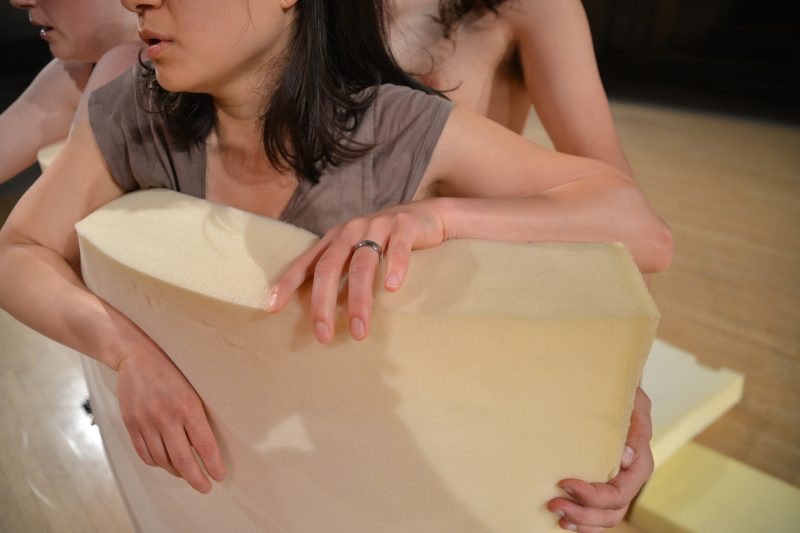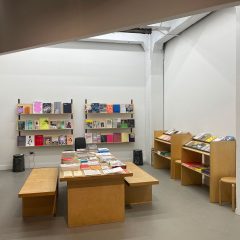Performers Meg Foley, Drew Kaiser, Jungeun Kim, and Annie Wilson have made a collaborative dance piece that is elemental, painstakingly handmade, rigorous, quotidian, emotionally present, and fiercely relational. The undergird will premier September 13-16 at the Icebox Project Space in the Crane Arts Building as a part of the 2018 Fringe Festival. I caught up with Meg Foley at her space The Whole Shebang to see a rehearsal of for the show. Later we spoke about her process and using movement to complicate and reinvigorate spoken language.
Levi Bentley: What does the title of the piece The undergird mean?
Meg Foley: It’s about going inward. I was thinking of what’s inside structures, like rebar, and of how bridges are held up. The undergird is the thing that runs throughout but perhaps is not visible. The singularity of the noun also felt important.

LB: How would you describe the form of the show?
MF: The piece is improvised, although pretty tightly scored based on a series of emotional arcs for the performers. Although we generally know where we are trying to get to, we sometimes encounter totally new things on the path to get there. The idea is that the score is organized to support that journey, and any divergence or newness that happens along the way. The score holds us up as we do it.
LB: How do performers’ individual experiences inform the piece?
MF: The experiences and anecdotes we work with are determined by our particular relationships to and experiences of grief. There is a central talking practice we all began with that I developed during the solo research period. In the quartet development, it became clear that to stay close to our grief stories, we may not all have the same performance goal or use the same performance task. So, in response to how people were connecting with their grief, we would determine which task was their path to take to get to the place of exposure.
The various parts feel emotionally raw and very personal. I think that’s where the heart of the piece is. Maybe we can help each other be at the edge of ourselves and safe. I don’t take for granted the degree to which Je, Drew, and Annie have brought their full selves to this process.

The characters in the piece seem to be very closely related to the performers. We are ourselves in the work. There are times where I may become a version of myself I may not be otherwise, but I’m not a character ever. From the start, in the solo, I knew I was in right place if I was scared while performing. I now feel relief and other feelings of toughness around how to be relational. I feel opened up and empowered by the risk.
LB: How did you balance being both a choreographer and a performer in a collaborative process?
MF: I was asking people to perform certain tasks or to move in certain directions, but I was also asking people to bring all of their emotional responses to the table as part of group choreography, with the choreographic goal of becoming close as a group. So any request, demand, or prompt was always viewed through the frame of relationality and consent.

LB: Do you think it’s important for your work to provide a stable story or meaning?
MF: The undergird works with philosopher Emmanuel Levinas’s distinction between “the saying” and “the said.” It attempts to deconstruct speech and story in order to amplify “the saying” towards an accumulated, but never singular, “said”. Every time we want to give and put language to a feeling, to offer it, it evaporates. So we stay very close to sensation and move through side doors.
LB: This active engagement in the moment of figuring out in a relationship with other performers and the audience seems like something you’re invested in across all of your work. How would you say The undergird differs from or moves beyond your earlier work?
MF: I was always interested in the IDEA of identity and the CONCEPT of relationship, as opposed to a particular relationship, or a naming of a particular self. I was interested in the shape of the container and the surface of things. Now, I am chasing this absolutely actual embodied presence that exists in dialogue.
LB: What do you want the audience to come for and to go home with?
MF: I want people to come to see it, to bear witness, and to really be with us. I hope people feel available, opened, and resonant with goosebumps. I hope they feel activated in their own reflection and consideration of what transpires. I hope they feel the sensation of intimacy — it’s hard to describe, but you know it when you have it.

The undergird, September 13-16, Icebox Project Space, 1400 N. American St. Purchase tickets online. For more information about Meg Foley visit her website.
Levi Bentley organizes the reading series Housework and edits the journal Boneless Skinless, featuring work by Housework participants. A chapbook of poems “Bucolic Eclogue” was released from Lamehouse Press in July 2016. Levi has worked in publishing for a variety of clients including Copper Canyon, Ugly Duckling Presse, LUMA Foundation, and Jacket2 reissues at Kelly Writers House. They live in Philadelphia.









